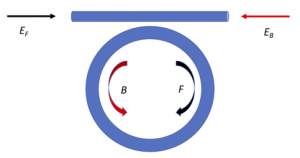The first ever described optical nonlinearity is the Kerr effect discovered in Scotland by John Kerr in 1875. In the presence of strong electric fields the refractive index of a medium can change depending on the local light intensity. Detailed derivations from the Schrödinger equation and the density matrix show that the Kerr effect is due to saturation of the quantum mechanical interaction between light and matter.
Optical resonators (or cavities) efficiently store and strengthen light and thus enhance nonlinear optical phenomena that, typically, require very high-power optical pump sources. These nonlinearities, including the Kerr effect, can then be observed at extremely low powers in optical resonators (see Figure 1) and even in micro-ring resonators which are typically of micrometre to millimetre in size (see Figure 2).
|
|
|
| Fig. 1: A Kerr resonator | Fig. 2: A micro-ring Kerr resonator |
Recent CNQO research has focused on:

